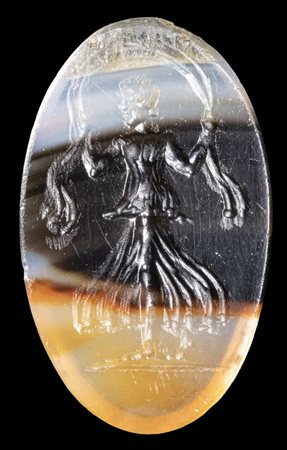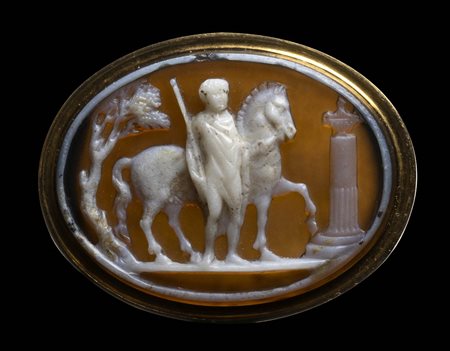ASTA 267 - GLITTICA
-

Lotto 145 A ROMAN BURNT BANDED AGATE INTAGLIO. YOUNG SHEPHERD PLAYING WITH A HARE.
1st-2nd century A.D.
10x12x3 mm
The male figure is facing left, playing with a hare. Slighlty burnt surface.Wear marks.
Provenance: U.K. private collection -

Lotto 146 A ROMAN NICOLO INTAGLIO. MARS GRADIVUS.
2nd century A.D.
14x19x4,5 mm
The helmeted god is standing left, wearing spear and trophy. Wear marks and traces of the iron mounting.
Provenance: U.K. private collection -

Lotto 147 A ROMAN BANDED AGATE INTAGLIO. AURORA.
1st century A.D.
9x14x2 mm
Beautiful depiction of Aurora advancing to the left, holding her cloak raised by the wind with both hands. Interesting choice of banded agate. Wear marks.
Provenance: From the Sangiorgi collection (1886-1965). Private coll., Monaco, 1970's13/05/202; thance by descent. Christies sale December 2017, lot n.3 ; U.K. private collection. -

Lotto 148 A ROMAN BANDED AGATE INTAGLIO SET IN A GOLD BOX-SETTING. MYTHOLOGICAL SCENE.
1st - 2nd century A.D.
15 x 16 x 3 mm ; 1,7 grs
A young man is discussing with an old one seated on the ground. Probably a dialogue between Socrates and a young male figure. Stone is brocken in two parts but well fix in the frame. Beautiful variety of banded agate. Wear marks.
Provenance: From the collection of an European gentleman, acquired on the art market -

Lotto 149 A ROMAN CARNELIAN INTAGLIO. NIKE WITH A TROPHY.
1st - 2nd century A.D.
14 x 16 x 5 mm
Still on its fragmentary iron mounting, the intaglio depicts Nike with a military trophy writing on a shield. Her right foot on a rock. In the field the latin letter "C" . Wear marks.
Provenance: U.K collection acquired on the art market -

Lotto 150 A ROMAN RED JASPER INTAGLIO. HERCULES CAPTURES THE DOE OF CERINEA.
1st - 2nd century A.D.
12 x 14 x 2 mm.
The doe of Cerinea was, in Greek mythology, a doe with golden horns, silver and bronze legs that have been dedicated to Artemis by the nymph Taygete when the goddess had saved her from being pursued by Zeus. Cerinea's doe fled without ever stopping, bewitching those who pursued her, thus dragging them to a country from which they would never return; since she was a sacred doe, her blood could not be shed. When Heracles was commissioned by Eurystheus to capture it, initially he limited himself to chasing it: the doe took refuge by climbing a mountain called Artemisio and tried to cross the Ladon river, but during the crossing Heracles managed to capture it by hitting it with an arrow in one point of the cartilaginous paw, therefore devoid of blood vessels; then loading it on his shoulders he carried it to Arcadia. The doe was finally taken to Mycenae and released there. The subject rarely appears on the gems. In this stone the hero faces left and stands over the sacred doe, holding it by the horns and pressing his right knee on his back to block it. Hercules' body is in muscular tension showing off all its legendary strength. A club behind him. Probably inspired by a Greek model. Fine detailed execution for the size. The physiognomic features of the hero recall the Antonine portraits. Signs of wear.
Provenance: U.K. private collection acquired in the british art market. -

Lotto 151 A FINE ROMAN TWO LAYERED CAMEO SET IN A GEORGIAN RING. VOTIVE SCENE.
1st century A.D.
Stone 16x21 mm; int. Size 16,5x22 mm; 4,57 gr.
A male character is standing, three-quarters facing right. With his right hand he holds a rod (or scepter), with his left hand he holds the bridle of his horse which is behind him, facing right in profile. The man is wearing a traveling cloak with his legs uncovered. On the left, a tree; to the right, a half-column with a cinerary urn above it. The scene probably requires more research for its full identification. Paoletti, in his glass impression collection, identified the subject (but without landscape and urn on the column) as one of the Dioscuri. The scene seems inspired by bas-reliefs. The male figure is characterized by physiognomic features that can probably be referred to the Augustan age. The horse is inspired by classical Greek models. The man seems to arrive in a bucolic place to contemplate or visit the incinerated remains of a family member or a comrade in arms.Very fine style and beautiful execution. Wear marks. Little missing on the edge and frame.
For a very similar scene and style, see: L.P.Biroli Stefanelli, La Collezione Paoletti, vol. I, p. 41 n. 150 ("Polluce uno delli Dioscuri" from a sardonyx intaglio).
Provenance: U.K. private collection acquired on the art market. -

Lotto 152 A LARGE ROMAN CARNELIAN INTAGLIO. EROTIC SCENE WITH A SATYR AND A RAM.
1st - 2nd century A.D.
17 x 20 x 3 mm.
A satyr with an erected phallus threatens to rape from behind a ram, holding its fur on its back and a ribbon which the animal holds in its mouth. Groundline. Large size. Fine execution. Great subject. Wear marks
For a similar scene: J. Boardman, C. Wagner, Masterpieces in miniature. Engraved gems from Prehistory to the present, p. 181 n. 167.
Provenance: From the collection of an European gentleman, acquired on the art market -

Lotto 153 A ROMAN CARNELIAN INTAGLIO. EROTIC SCENE.
1st century A.D.
10x12x4,5 mm
Erotic scene of two standing satyrs, each with a pedum. The older satyr appears to enter from behind the younger one, who looks back at him. Traces of the ancient iron mounting. Wear marks.
Provenance: From a private collection, France, acquired on the London art market 1990s-early 2000s -

Lotto 154 A ROMAN CARNELIAN INTAGLIO. MYTHOLOGICAL SCENE.
2nd century A.D.
15x22x6 mm
On the left, a dancing male character facing on the right a seated Pan on a rock. On top, a star. Probably an erotic scene. Large stone and wear marks.
Provenance: U.K. private collection -

Lotto 155 A ROMAN RED JASPER INTAGLIO. EROS HUNTING WITH A DOG.
2nd century A.D.
8 x 10 x 2 mm
The winged god is facing left holding a spear with his dog. Groundline. Wear marks.
Provenance: From the collection of an European gentleman, acquired on the art market -

Lotto 156 A ROMAN CARNELIAN INTAGLIO. DIOMEDES WITH PALLADIUM.
1st-2nd century A.D.
16x18x6 mm
The seated hero is facing left, holding with his right hand the palladium. Groundline.Wear marks and traces of the iron mounting.
For a similar iconography see: MORET, J.M., Les pierres gravées antiques représentant le rapt du Palladion, 1997
Provenance: U.K. private collection -

Lotto 157 A ROMAN CARNELIAN INTAGLIO. WARRIOR.
1st - 2nd century A.D.
11x14x3 mm
The warrior faces left and is characterized by a muscular and powerful body. He holds the sheathed sword in his right hand, the spear in his left. Below, the shield; long cloak over the shoulders. Rocks behind the figure. Wear marks and chip on the edge.
Provenance: U.K private collection -

Lotto 158 A ROMAN JASPER INTAGLIO. VEILED PRIESTESS.
2nd-3rd century A.D.
13,5x15x2 mm
The veiled woman is seated facing left, holding in her right hand the palladium and her left one the scepter. Groundline. Probably a vestale or Cassander. Minor chips on the edge.
Provenance: U.K. private collection -

Lotto 159 A ROMAN FRAGMENTARY GOLD RING SET WITH A CARNELIAN INTAGLIO. BUST OF ASCLEPIOS.
1st-2nd century A.D.
Stone 13x15 mm; 2,24 gr
The god is facing left, the back in three-quarters. He is laureated and with his stick intertwined by a snake. Wear marks. The mounting is fragmentary (hoop missing).
Provenance: U.K. private collection -

Lotto 160 A ROMAN CARNELIAN INTAGLIO. BUST OF JUPITER.
1st century A.D.
7x10,5x3 mm
The divinity is turned to the left, with the modius on top of the head and the tunicated bust. Considering the very small size of the stone, the work is performed with great technical skill. Wear marks.
Provenance: U.K private collection -

Lotto 161 A ROMAN AGATE INTAGLIO. BUST OF ZEUS SERAPIS.
1st - 2nd century A.D.
14x18x5 mm
The effigy is facing left, with the tunicated bust and the modius on top of the head. The deity is engraved in the caramel brown layer of the agate over the thicker white layer, creating a attractive contrasted effect. Wear marks.
Provenance: The Gustave Mustaki collection, exported from Egypt under licence c.1950 and gifted to Elsa MacLellan, his daughter, thence by descent. -

Lotto 162 A ROMAN AGATE INTAGLIO. BUST OF ZEUS.
1st century A.D.
12x14x6 mm;
The god is facing left wearing the modius. Wear marks.
Provenance: Formerly Swiss private collection, acquired in the early 1990's, then by descent, family collection since 1998. This lot is sold under temporary import status. -

Lotto 163 A ROMAN SARD INTAGLIO SET IN A LATER GOLD RING. BUST OF ZEUS SERAPIS.
1st century B.C. - 1st century A.D.
Stone 10x12 mm; Int. Size 15x18 mm; 5,80 gr
After a Greek Late Hellenistic model. Frontal bust of Zeus Serapis with a large ornated modius on top of the head. The stone is cracked across the eye. Some missing on the modius. Wear marks.
Provenance: U.S. private collection, acquired on the art market. This lot is sold under temporary import status. -

Lotto 164 AN EASTERN ROMAN CARNELIAN INTAGLIO SET IN A REVIVAL GOLD RING. HEAD OF JUPITER SERAPIS.
2nd - 3rd century A.D.
Stone 12x14 mm; int. size 18,5x19 mm; 13,50 gr
With lobed hoop, flatten within and surmounted by a large oval box setting with a twisted gold wire. The intaglio shows the god facing left, characterized by a long beard and hair adorned with a band and stylized triangular modius. Wear marks.
Provenance: U.K. private collection -

Lotto 165 A ROMAN RED JASPER INTAGLIO. BUST OF ZEUS SERAPIS.
1st - 2nd century A.D.
10 x 12 x 2 mm
Facing left, with radiated crown and modius. Chip on the edge. Wear marks.
Provenance: U.K collection acquired on the art market -

Lotto 166 A ROMAN BURNT AGATE INTAGLIO SET IN A MODERN GOLD RING. BUST OF HERMES.
1st - 2nd century A.D.
Stone 9x12 mm; int. size 16x19 mm; 17,42 gr
The deity is depicted with the three-quarters bust to the right and the head slightly three-quarters facing to the left. The bust is draped, the wings on the head and the caduceus behind the shoulder. Burnt stone.
Provenance: From a private collection, France, acquired from Galerie Mariaud de Serres, Paris, in the early 2000s -

Lotto 167 A ROMAN SARD INTAGLIO. BUST OF HERMES WITH THE CADUCEUS.
1st-2nd century A.D.
12,5x15x2 mm
Bust of young Mercury, almost to the chest, facing left. In front of him, the caduceus. Nice vivid tone. Wear marks.
Provenance: From a private collection, France, acquired From the Galerie de Serres, Paris in the 1990s-early 2000s -

Lotto 168 A ROMAN NICOLO INTAGLIO. BUST OF HERMES WITH A STAR.
1st - 2nd century A.D.
7,5 x 9,5 x 2 mm.
Bust of young Hermes facing left with winged cap and star.
Provenance: U.K. private collection acquired in the british art market.
